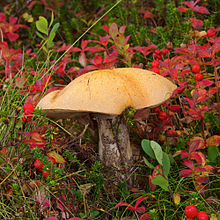Leccinum versipelle
| Leccinum versipelle | |
|---|---|

| |
| Scientific classification | |
| Kingdom: | Fungi |
| Division: | Basidiomycota |
| Class: | Agaricomycetes |
| Order: | Boletales |
| Family: | Boletaceae |
| Genus: | Leccinum |
| Species: | L. versipelle
|
| Binomial name | |
| Leccinum versipelle | |
| Synonyms | |
| |
Leccinum versipelle, also known as Boletus testaceoscaber or the orange birch bolete, is a common edible mushroom (given the right preparation) in the genus Leccinum. It is found below birches from July through to November, and turns black when cooked.
Description[]

The cap is broadly convex, bright red-brown or brick red. It is felty and grows up to 20 cm (8 in) in diameter. The flesh is white to pink, turning green-blue when cut, particularly in the stipe. The spores are brown. The stipe is firm, long and slender, white and covered with small black scales.
Edibility[]
Leccinum versipelle is mildly toxic (causing nausea and vomiting) unless given proper heat treatment: frying or boiling for 15–20 minutes is considered necessary. As mentioned, the mushroom turns black when heated.
It is commonly harvested for food in Finland,[1]Latvia, Lithuania, Estonia, Belarus, and Russia.
See also[]
References[]
- E. Garnweidner. Mushrooms and Toadstools of Britain and Europe. Collins. 1994.
- Leccinum
- Fungi described in 1835
- Fungi of Europe
- Edible fungi
- Taxa named by Elias Magnus Fries